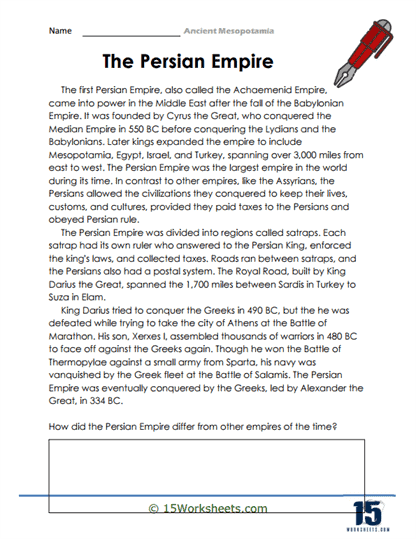The Persian Empire

Worksheet Description
The first Persian Empire, also called the Achaemenid Empire, came into power in the Middle East after the fall of the Babylonian Empire. It was founded by Cyrus the Great, who conquered the Median Empire in 550 BC before conquering the Lydians and the Babylonians. Later kings expanded the empire to include Mesopotamia, Egypt, Israel, and Turkey, spanning over 3,000 miles from east to west. The Persian Empire was the largest empire in the world during its time. In contrast to other empires, like the Assyrians, the Persians allowed the civilizations they conquered to keep their lives, customs, and cultures, provided they paid taxes to the Persians and obeyed Persian rule.
How did the Persian Empire differ from other empires of the time?
To engage with this worksheet, students should first immerse themselves in the narrative, reading the historical account attentively. As they progress, it’s beneficial to underline or make mental notes of significant events, rulers, or features of the Persian Empire. After fully understanding the text, students should reflect on the concluding question, comparing and contrasting the Persian Empire’s attributes with what they know about other empires of the same epoch. Crafting a well-thought-out answer to the posed question, utilizing the information provided and any supplementary knowledge, will complete the worksheet’s task.
By weaving a chronological narrative, the worksheet underscores the empire’s significant rulers, territorial expanse, administrative innovations, and pivotal confrontations. Beyond mere facts, it nudges students to engage in comparative historical analysis, fostering a deeper comprehension of the uniqueness and significance of the Persian Empire within the broader tapestry of ancient civilizations. Through this learning journey, students are not only familiarized with the empire’s history but also encouraged to think analytically about its place and impact in the ancient world.
